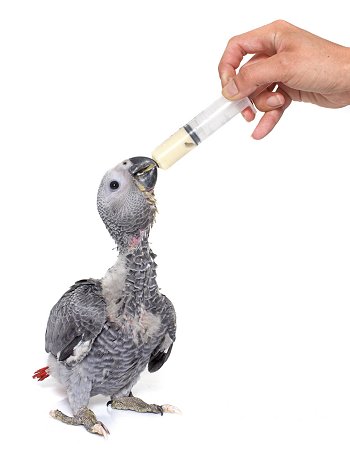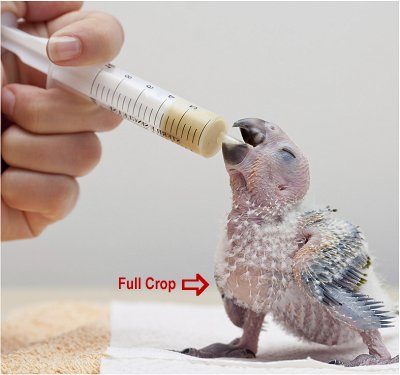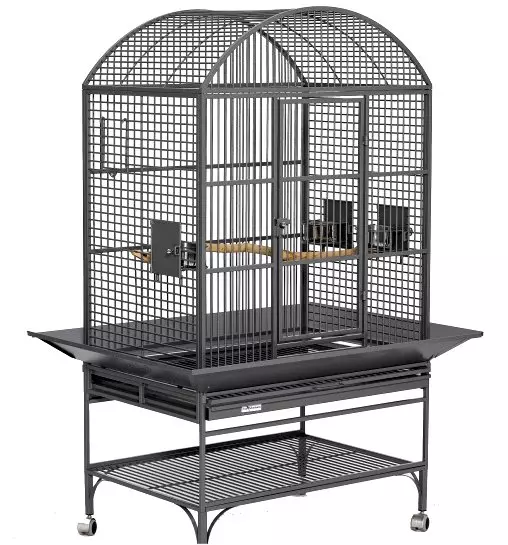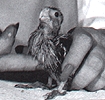A Healthy Baby Bird Now Is Only Backing Up Balancing
Pet Wellness, Interesting Facts, and Trivia
Printable Instructions For Hand-Feeding Infant Birds

Saving Lives
The idea of a new baby bird in the family is an heady proffer that brings a new dimension to your life. However, if you make up one's mind to paw-feed your new pet, you will need some knowlege, a lot of patience, and a good diet for a growing bird.
Veterinarians and naturalists have developed techniques for hand raising nesting birds, and in that location are now easy-to-use special babe bird formulas for feeding the ever-hungry little babies. Higgins Intune Baby Bird Hand Feeding Formula and Higgins Intune Hi Energy Baby Macaw Hand Feeding Formula are super foods that meet the extraordinary nutritional needs of these unusually fast growing babies. It is rice based (sourced from North America) and corn free. inTune® Natural Hand Feeding uses natural and salubrious, high end sources for nutritional fat like kokosnoot oil and macadamia nut meal. Information technology is also the just commercial hand feeding formula on the market with natural assistant & mango odor. The demand to cook the formula has also been eliminated. It can now be prepared with hot water!
Nigh infant birds get in in the world moisture, naked, bullheaded, and too weak to support themselves. When fallen from their nest, survival is questionable. At present, with help, they are able to grow and develop ordinarily. Wild birds tin can exist raised and returned to nature. Pet birds larn to have people every bit friends. The real benefactors, though, are people. Nature returns many-fold for kindness performed.
Hand-Feeding
The most important considerations in the hand feeding process are the frequency and volume of feeding. Baby birds grow at an extraordinarily rapid rate and this growth requires a cracking deal of nutrient to meet the nutritional needs of the bird. Still, the crop of a immature bird holds a limited amount of food, and then information technology must be filled ofttimes. As the bird gets older, the chapters of the crop increases, and the number of daily feedings will be reduced. The volume to be fed is base upon a combination of ascertainment and sentence.
 Procedure
Procedure
Check the Fullness of the Crop
Nature designed a rather unique feature into the digestive system of birds-a widening of the oesophagus at the lower pan of the cervix This widening acts as a compartment to hold a quantity of food, and is named the ingather.
The ingather can be easily visualized in young birds while feathering is incomplete. In older birds with a well developed roofing of feathers, the fullness tin can be checked by gently feeling the crop with a thumb and index finger.
The crop should be examined before each feeding. Ideally, in the rapidly growing immature bird, the crop should never be allowed to become completely empty. Checking the ingather fullness will help determine the frequency and volume of feeding to be given. Unremarkably the crop will empty in iv hours. A crop that remains total or is not emptying properly indicates some type of trouble.
Position Bird for Hand-Feeding.
Wild birds are best fed while in a nest box. They will open their beaks and gape, making feeding very easy. Avert excessive handling of wild birds. Pet birds are removed from the nest box and placed on a towel. By cupping a hand gently effectually the baby during feeding , adequate support will exist given to position him for eating.

Advisedly Introduce Feeding Device into the Mouth.
The introduction of an centre dropper or syringe into the mouth is relatively piece of cake, as the baby birds will be eager to be fed and will exist gaping (opening the beak wide in order to receive the feeding). Occasionally, a bird may non gape, and gentle borer of the beak with the feeding device will encourage the bird to open its nib. The device should be advisedly passed into the left side toward the right side of the mouth.
Administration of the formula should exist synchronized with swallowing. Birds swallow with an unusual rhythmic bobbing of the head upward and down. While the bird is swallowing, the formula is delivered apace. With do, a "feet" for the process develops, and, done efficiently, the filling of the crop tin can be accomplished in a surprisingly brusque time.
Volume of formula to be Given
The volume of food given is of critical importance. overfilling of the crop could pb to backflow up the oesophagus, into the throat, and down the windpipe, which could cause death. Under-filling the crop might consequence in starvation.
Every bit t he food material is being delivered, the ingather will begin to fill and bulge in the region of the lower neck. Conscientious observation and experience are necessary in order to determine when the crop is adequately filled.
Ofttimes, the bird will finish gaping when the crop is filled; nevertheless, some birds, volition continue to gape even when filled. Watch closely when filling for any evidence of nutrient material bankroll up into the mouth. If this occurs, immediately stop until the oral cavity is cleared.
When the bird appears to have had plenty feeding material, determine the state of fullness of the crop to make sure a sufficient amount of feeding was delivered.
 Any backlog food material on the pare, beak or feathers should he removed with warm water when the feeding is consummate. Information technology can be followed with a few drops of warm water to aid in "cleaning the mouth." Feeding utensils should be cleaned immediately after use. Bank check the anus to be certain no fecal matter has accumulated. Ideally, monitor the bird'southward weight daily with an authentic calibration. A salubrious babe gains weight daily.
Any backlog food material on the pare, beak or feathers should he removed with warm water when the feeding is consummate. Information technology can be followed with a few drops of warm water to aid in "cleaning the mouth." Feeding utensils should be cleaned immediately after use. Bank check the anus to be certain no fecal matter has accumulated. Ideally, monitor the bird'southward weight daily with an authentic calibration. A salubrious babe gains weight daily.
Preparation of Babe Bird Formula
Follow the manufacturer'due south directions when mixing the formula.
Important: "Employ distilled or boiled water to eliminate bacteria growth from contaminated tap water." The water should be approximately 105-110 degrees. Add the water to the powder gradually while stirring. Subsequently thorough mixing to eliminate lumps, the formula should exist the consistency of flossy pudding. This thickness will allow it to be fatigued into an eye dropper or syringe or will roll off a spoon. For older birds the mixture may be made thicker.
Practice not reuse mixed formula. Discard and mix fresh at each feeding.
If really necessary, sufficient amount of formula may be prepared at one time to last 3 days if covered and refrigerated subsequently preparation. The amount needed for each feeding can exist heated and fed but non reused. Caution: You might need to add h2o in the heating process. Diluting formula by increasing water volition reduce the concentration of the diet.
Temperature to Feed Formula
The formula should be served warm- 104-106 F- but not hot, equally excess estrus may damage the digestive tract. Information technology should experience Slightly warm to the touch. It is highly recommended to use a thermometer to measure out the temperature.
In guild to maintain the oestrus of the manus-feeding formula mixture, a double-banality type arrangement tin be gear up with the container of prepared formula placed in a bowl or pan of warm water during the feeding process.
Feeding Expanse
Psittacine birds while being fed should be placed on a surface, such as a towel, where there will be insulative properties to preclude excess heat loss and a surface where they can grip with their feet, preventing slippage and possible injury.
Frequency of Feeding
Cockatiels and Minor Parrots
Baby birds can exist removed from their parents from betwixt 8 to 21 days. Waiting until ii ane/2 to iii weeks is safer for the beginner, equally the bird is hardier due to the presence of some feathering.
Hatching to 1 week.
If the bird was removed from the nest shortly after hatching, for any reason, feeding requires special care. At that place should be no attempts to feed the bird for at to the lowest degree 12 hours subsequently hatching. The crop is very small and volition hold merely a express amount of nutrient. Subsequently connected use, it will expand. The kickoff feeding at 12 hours should be one driblet of water. Approximately 1/2 to 1 60 minutes later, another drop of water may be given. Feeding too oftentimes during this menstruum may overload the crop and lead to aspiration and death.
After these initial feedings, if the baby appears normal and is excreting, a few drops of very thin formula can be given. In club that the infant bird receive enough nutrient, the paw-feedings are repeated every two hours around the clock.
One to 2 weeks - Birds can be fed every 2-3 hours around the dock. If the birds are kept peculiarly warm and comfy, the night feedings afterwards midnight tin be eliminated. However, feedings must begin once more at six:00 AM.
Two to three weeks - This is a relatively safe age to remove the baby birds from the nest for hand-feeding. It is easier to cheque the crop and feed them. The birds of this age can be fed every three to 4 hours from six:00 A.M. to midnight.
Three to four weeks - Feed the birds every four hours. As feeding frequency tapers off, the formula tin can be slightly thickened. At 4 weeks, the birds can be put in a muzzle with low perches. Water in a bowl may be placed inside.
5 to six weeks - Feed the birds twice daily. A pelleted bird nutrient and other foods may exist placed in the cage to encourage the bird to eat on its ain.
Seven weeks - Birds should be placed in a large cage with pellets in cups and scattered on the floor. Introduce the birds to a variety of succulent foods, but these should not brand up more than 20% of the diet. Vegetables such as peas and corn are well accepted.
Weaning
Birds should non be weaned before 7 weeks, usually most 8 weeks. Before weaning the bird off mitt-feeding, go along shut spotter to see that the bird is actually eating adequate amounts of pellets on its ain and not simply nibbling at the food. Handle the crop to make up one's mind the fullness and bank check the breastbone for degree of muscling. A weaning bird may lose every bit much as x% of it's weight usually. Whatsoever more than than that may exist an indication of a trouble. It is recommended that the bird be weighed regularly through this menstruation.
When first weaning the bird, give them pellets, every bit these are a nutritionally complete and balanced diet for the bird. It is a good idea to keep an older bird in a cage next to the cage with the young weanling to teach them to eat through mimicry.
If the infant birds are non weaned, they will become "spoiled" and will not eat on their own, preferring to exist hand fed. However, if they are weaned too early, they will not eat adequately, gradually lose weight, get weak and die. Therefore, if baby birds are begging to be fed, even afterward they are weaned, there may need to be a reversal dorsum to paw-feeding as they may not be eating adequately.
FREQUENCY OF HAND-FEEDING COCKATIELS and SMALL PARROTS
| Age in Weeks | Number of Daily Feedings |
| 0 | Every 2 Hours (Effectually the Clock) |
| 1 | Every 2 Hours (Effectually the Clock*) |
| two | Every 3 Hours (half-dozen a.m. to Midnight) |
| 3 | "Safest" Catamenia To Begin Hand Feeding Every four Hours (6 a.1000. to Midnight) |
| 4 | Every 5 Hours (half dozen a.m. to Midnight) |
| 5 to 7 | Ii Feedings Daily |
*If bird is kept peculiarly warm and comfortable, the 2 a.chiliad. and 4 a.m. feedings can be eliminated.
Weaning Catamenia - Important -
Brand certain bird is eating adequately on its own earlier discontinuing manus-feeding. Check fullness of crop.
Housing and Rut
A small cardboard box approximately 12" x12"xl2" or a small fish aquarium with layers of paper towels over a one inch padding of cloth towelling on the bottom volition serve every bit an incubator and holding area while the babies are immature. A heating pad is placed nether 1/2 of the box or aquarium. A towel is placed over the summit. Either the heating pad setting or the amount of the meridian that is covered by the towel may be adjusted to provide a constant 85-90' for non-feathered birds. The temperature is gradually reduced equally they become feathered and mature. It is recommended to observe the babies carefully to determine their comfort level. A cold baby will shiver and a baby that is too hot will non sleep well and will breathe heavily through an open mouth. A bottle or tin filled with water and holes punched in the lid to allow for evaporation will help to provide humidity.
WILD BIRDS
Frequency of Feeding
The frequency and volume of feedings given to baby birds are largely determined by their historic period. Judging the age of wild birds is difficult if untrained, so the best manner to decide feeding requirements is through the use of readily observable changes in the bird. For instance, whether or non the eyes are open, and if the bird is standing upward "off their hocks."
Before the eyes are open
If the baby birds appear strong and are peeping with their mouths gaping open, so they tin can eat as much as they want. Ideally, baby birds of this young age should exist fed every 15-twenty minutes until their eyes are open. They can go up to thirty minutes without a feeding with no sick effects; however, more frequent feedings are preferred. They practise not require around-the-dock feeding every bit in nature, they are fed only during daylight hours. In accord with this, they are given feedings for a 12 hour menstruum. Withal, hand-feeding wild birds is quite a delivery, every bit it requires nearly 50 feedings per day.
When the optics are open
As the bird becomes older, the frequency of hand-feeding can exist reduced and the volume increased. Efforts can be initiated to get the bird to swallow on its own. When a bird initially opens its eyes, it tin can be fed every half hour unless hungry or peeping.
When birds are "off their hocks"
When birds go stronger and begin to stand on their legs ("off their hocks'), and then feedings tin be given every 45 minutes. Time between feedings can steadily increased, and when the bird is out of the nest, feedings can exist given at 2 hour intervals.
FREQUENCY OF Mitt-FEEDING FOR WILD BIRDS
| Age | Number of Daily Feedings |
| Before Eyes Are Open up: | Feed Bird Every 15 Minutes (12 Hour Period) |
| Eyes Are Open up: | Feed Bird Every 30 Minutes (12 Hour Menses) |
| Off Their Hocks | Feed Bird Every 45 Minutes (12 Hour Menses) |
| Bird Out Of Nest: (Standing On Their Own) | Feed Bird Every 2 Hours (12 Hour Period) |
*Wean at 15 Days
Important-Bird must exist eating fairly on its own.
Weaning
Wild birds should begin showing interest in their environs and start to eat on their ain by 15 days. Provide live food (meal worms) and grass, twigs, etc. in the nest to stimulate involvement in the environment. Spreading seed on the bottom of the nest volition also encourage the bird to eat on its own.
During the weaning menstruum, it is disquisitional to go on a close lookout on the bird in order that good diet is maintained. Many times, a bird may be pecking at seed, giving the impression that it is eating, when in actuality, it is not taking in enough for maintenance. Therefore, it is very of import to observe if the bird is eating seed during this menstruum and regularly bank check the ingather for fullness.
If other immature birds who are eating on their own are present, placing the baby bird in the same muzzle will hasten socialization, and the bird will learn to eat on its own through the faux of others.
Housing For Wild Babe Birds
Following nature's design, a nest is constructed. The sides are formed from cloth rolled to a bore of 1 1/2 inches then forming a round shape like a doughnut. The nest would have a bore of iv-eight inches, depending upon the number and size of the babies. The 1 1/2' superlative makes the sides of the nest sufficiently high to keep the babies in the nest, but depression enough to allow the baby bird to scoot backwards and pass his waste over the side of the nest.
Newspaper towels are placed in the lesser of the nest to a depth of 1/two inch and so placed over the peak of the entire nest. The towels are arranged to form a sloping surface which enables the bird to back up to the top of the nest to eliminate, and the paper towels can exist hands replaced to maintain cleanliness.
Heat and Humidity
To provide oestrus in the nest box, a heating pad can be placed under half of the nest and dialed to a setting which will maintain temperature of 85-90 degrees for non feathered birds and gradually reduced every bit they become feathered. By placing heat under half the nest, the bird is able to select the area where the temperature is most comfy. The box should be kept covered. A canteen or tin filled with h2o and holes punched in the chapeau to permit for evaporation volition aid to provide proper humidity.
Caution
While raising wild birds is rewarding, please, do not make a wild bird a pet. For more than data contact your local Wildlife Bureau, local Rehabilitation Center, Humane Society, State Fish and Game Agency or the Federal United States Fish and Wildlife Service.
Weaning Pet Birds With Avi-Cakes Food
Your pet birds accept received a good start in life through the nutritional benefits of Nutri- Start baby bird food. Information technology is important to continue with high-quality nutrition during the weaning stage and beyond. Lafeber's Avi-Cakes are an splendid weaning nutrient for your birds.
When birds achieve the weaning phase, simply break Avi-Cakes into small pieces and spread them virtually the babies. They will get-go investigate the food; then, pick it up and start self-feeding. (Supply fresh Avi-Cakes daily.) When the babies are eating the Avi-Cakes you will first desire to eliminate the eye of the day mitt-fed meal. Equally the birds go on eating on their own, discontinue the morning and finally the evening manus-fed meal.
Since Avi-Cakes provide complete nutrition for pet birds, you may go along feeding Avi-Cakes or you may cull i of the other fine quality foods manufactured by Lafeber Company.
This bit of information was brought to you by Lafeber Bird Foods
hernandezkneand1992.blogspot.com
Source: https://www.futurepets.com/trivia/birds-handfeeding.htm
0 Response to "A Healthy Baby Bird Now Is Only Backing Up Balancing"
Post a Comment